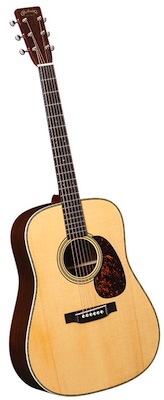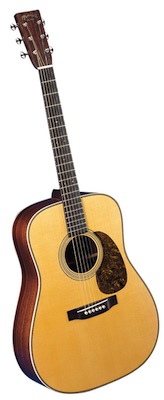This week we’re going to be looking at the differences between two slightly more disparate models, the Martin HD-28V and the D-28 Authentic 1941.


Martin D-28 Authentic 1941 Martin HD-28V
What’s the same?
Both of these instruments are 14-Fret dreadnought sized guitars. Both have a 25.4” scale length, 1-11/16” nut spacing and a 2-⅛” bridge spacing. Both feature ebony fretboards and Rosewood back and sides.
Top woods
The Martin HD-28V features a solid Sitka spruce top. Sitka spruce has been the standard top for Martin instruments since the end of World War II, switching from the Adirondack spruce that was used during the earlier years. The reason for the switch came down purely to supply. Pieces of clearwood (Pieces of wood without knots or major blemishes) Adirondack that were large enough to make guitar tops out of became too hard to obtain, forcing Martin to switch to Sitka in order to keep up with production demands. Sitka is a more flexible species of spruce which vibrates easily. This gives Sitka topped guitars a warmer, mellow tone. Since its first introduction, Sitka has become not just the standard for Martin but for the acoustic industry as a whole and its tone tends to be what most people associate with the sound of an acoustic guitar.
The D-28A 1941 on the other hand is constructed with a period correct Adirondack Spruce top (a.k.a. Red spruce or casually as Adi). In comparison to Sitka, Adi is a stiffer wood. This stiffness provides a brighter tone with an accentuated high end. This added brightness has lead many Bluegrass players to prefer Adi topped Dreadnaughts because of its ability to successfully cut through a cluttered acoustic mix on stage.
It should also be mentioned that since the start of 2015 Martin has been treating all of their Authentic models’ tops with their proprietary VTS treatment. This is a proprietary process that bakes the wood, breaking down the cellulose and water content, in essence giving the brand new top the same characteristics that a well played untreated Adirondack top may take years to develop.
Bracing
Before we dive into the specific bracing styles of these two guitars, first let’s start with a quick explanation of the the different ways braces can be shifted. Inside of most Martin guitars you’ll find what is known as an “X” brace. This X is made up of two individual braces that support the lower bout of the guitar, crossing each other at the center of the instrument. Over the years Martin has changed the exact position of this X numerous times, but on modern Martins the standard positing of the center of this X is about 1.5” from the soundhole. If the center of the X gets closer to the soundhole this is known as forward shifting. If the center is farther away it’s known as rear-shifting.
It should also be mentioned that both of these instruments feature standard scalloped, 5/16” braces. As mentioned in our previous blog entry D-28 vs HD-28:
"Scalloping is a process where braces are made concave by the luthier who carefully shaves away at the brace, arching it and making the center thinner than either end. The idea behind this is simple. The sound of a guitar is highly dependent on the vibration of the top. The more vibration the top gets, the louder and more bass heavy the guitar will be. Luthiers try to find the "sweet spot" for lack of a better term where there is as little bracing as possible so that the top can vibrate freely but still enough support to keep the guitar stable and structurally sound.”
The HD-28V is constructed with forward shifted “X” braces, with the center of the “X” sitting at 1” from the soundhole, half an inch closer than standard bracing. The purpose of forward-shifted bracing is to put less support underneath the lower bout of the guitar’s top, allowing it more flexibility which gives are more prominent bass response. Combine this with the HD-28V’s warmer sounding Sitka spruce top and you end up with a guitar with a ton of low end response. Depending on your playing styles and personal preferences, this can be seen as a distinct positive or as a negative. If you’re looking for that low rumbling bass from your instrument you truly need to look no farther than the HD-28V. However, it should be mentioned that depending on the strength of your attack that the bass can sometimes become a little loud and overpowering, drowning out the high notes.
The D-28A 1941 is constructed with rear-shifted bracing, the center of which sits at 1-⅞” from the soundhole. This positioning stiffens the lower bout of the guitar, reigning in the bass response and giving the instrument a more balanced, focused sound. To my ears the 1941 sounds almost reminiscent of an OM in terms of how balanced the lows are compared to the high notes. It should be noted that the Adirondack top also has a lot to do with this balance, as the the stiffness of Adi will also help make the treble notes more pronounced, helping to prevent them from being drowned out like they can be on the HD-28V.
Other differences
The following spec differences between the D-28 1941 and the HD-28V are identical to the differences discussed in our “D-28 Marquis vs. D-28 Authentic 1937” article. For more detailed explanations of these differences, please continue here.
Back/Side wood: Both guitars are constructed with Rosewood back and sides, but differ in their specific species. The HD-28V has Martin’s standard East Indian Rosewood (EIR) while the 1941 is made with Madagascar Rosewood. In my opinion the principle tone of an EIR guitar and a Madagascar guitar are almost identical. The differences are only really apparent in their harmonic response, where the Madagascar guitars may edge the EIR instruments out.
Neck Profiles: The HD-28V is made with a Modified V neck profile which is undoubtedly “vintage” inspired. It has sharper angles than most Martin necks and sits as a sort of happy medium between older Martin profiles and the sleeker modern profiles. The 1941 is made with a period correct Barrel & Heel profile, which will certainly come across as large to players who haven’t played vintage Martin’s before (Although, in my opinion at least, still very comfortable).
Glues: Like 99% of Martin instruments and most acoustics on the market today, the HD-28V is constructed using a white glue, while the 1941 is constructed using a period correct hide glue. Hide glue is certainly a harder glue for luthiers to work with although it’s an area of disagreement between guitar experts whether hide glue makes a tonal difference on an instrument.
As always, your comments are welcome below.